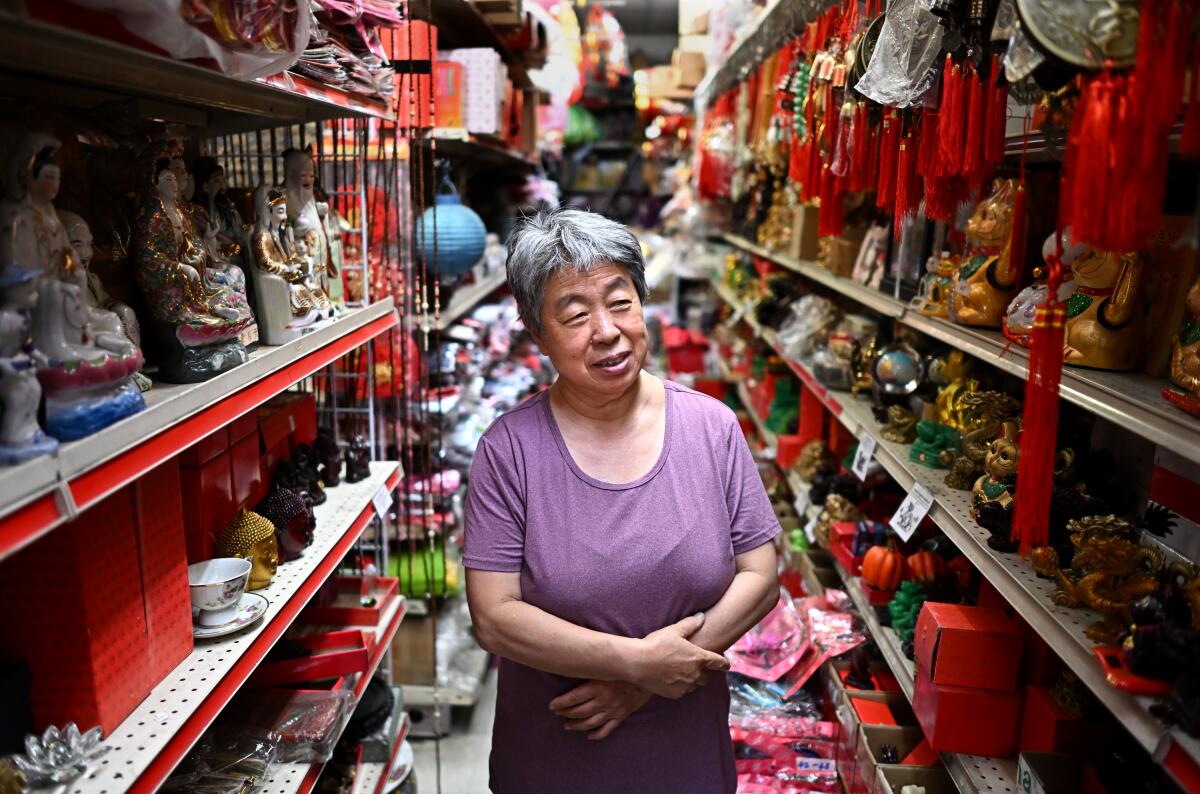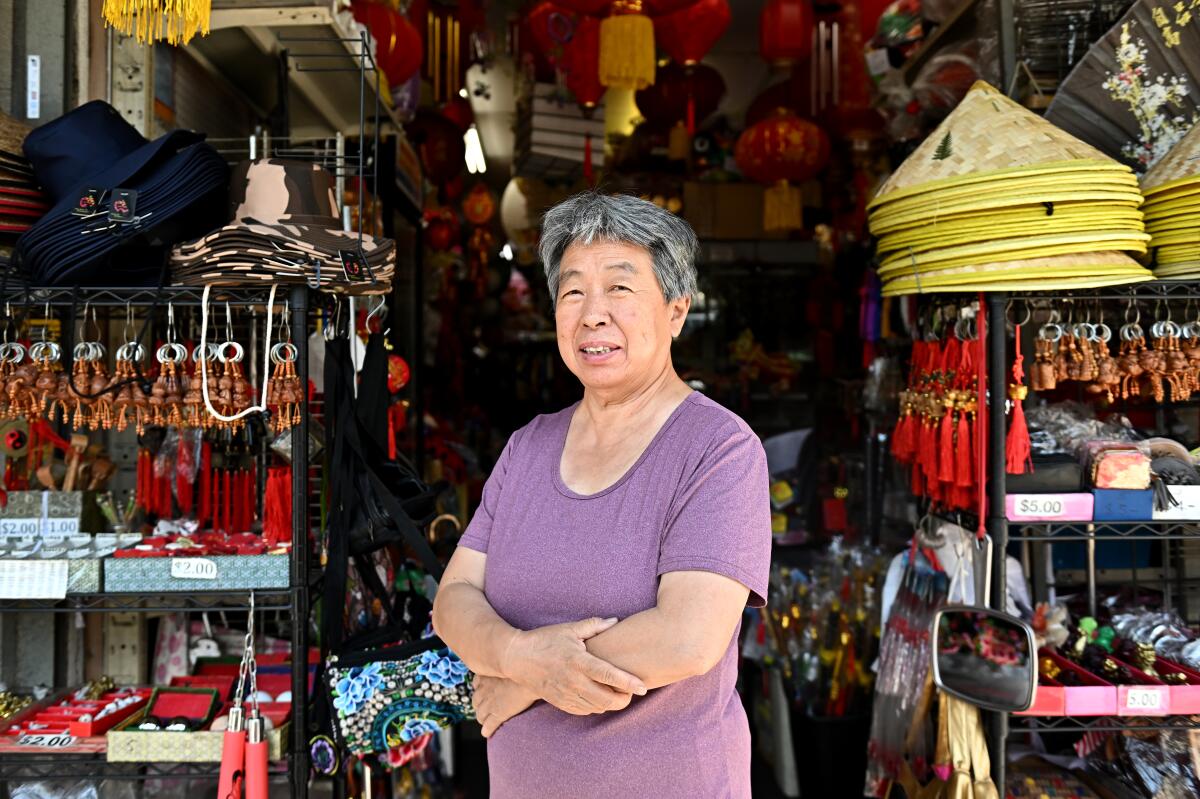Immigrant-run Chinatown gift shop embraces social media to navigate a changed neighborhood

- Share via
Shortly after I met Mary Wang, 71, in Chinatown a few years ago, I was drafted to provide tech support for her gift shop business, Jadetime E-gifts.
I set up an Instagram business account for her store, and tried to explain, poorly, how Instagram viral marketing worked.
Rather than being overwhelmed, Mary, who has run the store for two decades, was endlessly curious and eager to learn. She wanted to know how all those new, hip businesses in Chinatown were drawing so many customers.
Soon she was creating her own posts highlighting her inventory of traditional Chinese paper lanterns, bamboo fans and kimonos. Readers who learned about Mary in my column have stopped by to help write captions, take photos and offer other tips.
These days she has almost 200 followers and has connected with hundreds of new customers over the app. Every time I’m in Chinatown, I try to stop by for an update.
Our conversations have become a window into the life of an immigrant senior trying to run a business in an economy increasingly driven by apps, algorithms and search engines.
Newer, hipper businesses have flocked to Chinatown over the last decade and turned it into a viral dining destination. Mary was always curious and eager to participate in the new Chinatown, but a lot of things stood in her way.
She grew up in Beijing and came to America in the 1980s. After a year working a sewing machine at a garment factory in New York City (too crowded, too loud, Mary says), she came to Los Angeles.
She started out supplying other gift shops with inventory, manufactured in China at her brother’s factory. When import costs got too high, she opened her own storefront in 2000.
Well, technically, it was Mary’s daughter Jia who did all the paperwork.
Jia, 43, has been helping run the business behind the scenes ever since she was old enough. Her parents never asked her and her sister to work at the store, but as an adult she decided to take on some responsibility. In addition to a day job as a president of a logistics company, she handles Jadetime’s paperwork, accounting and anything else that might require English. She also created their website, which launched in 2009.
Jia said their family has always tried to stay with the times. Jadetime has a Facebook page and was one of the first, if not the first, Chinatown gift shops to start selling online, Jia said. They filled orders from as far away as Australia, and even supplied other Chinatowns in New York, Texas and Portland, Ore.
They expanded to four gift shops around the downtown area. Television shows and weddings became a big source of business.
But Jia could only run the website in her spare time, and her full-time job didn’t leave much. When she had her first child in 2014, she stepped back from the business.
“I still do all the paperwork, though, just late at night after the kids go to sleep,” Jia said.
It’s hard to see what the future of the business will be, Jia said. Her parents are retired, and primarily run the stores to stay active. But she’s concerned the neighborhood won’t support businesses like her parents’.
“If these big companies keep buying out these smaller mom-and-pop commercial buildings, it’s not going to be Chinatown any more,” Jia said. “And there’s still a need for a Chinatown. It’s a tourist draw, and brings in a lot of money when people are traveling.”

When I caught up with Mary a few afternoons ago, she was dealing with another technical issue that day: Someone had edited their Google business page to show the business as temporarily closed.
Mary couldn’t remember her Google password, so I let Jia know and she took care of it.
She had made $57 so far — a good day.
She usually gets a trickle of customers around noon, and another in the evening. Some days there are no customers. The closure of Ai Hoa Market two years ago has caused a sharp downturn in foot traffic.
But on that day, some combination of algorithmic luck and the internet’s whims had brought her a customer looking to buy paper fans in bulk.
Stella Zarati, 29, of Upland runs a small business on Instagram decorating the fans as accessories for raves, parties and music festivals. She found Jadetime by typing “traditional Asian fans” into the Apple Maps app — it was one of the only results.
The store’s most recent and reliable customers have been people like Zarati, who want affordable ways to create looks for social media posts, cosplaying, weddings, television shows and other events.
It shows that there’s good and bad in all this new technology that increasingly and invisibly drives our economy.
Social media rendered Jadetime E-gifts invisible, but it also created a new kind of demand for Mary’s products that might not have existed without influencer culture.
I’m not here to ask you to smash your smartphone, quit social media and turn back the clock.
I just want to point out that the ultra-maximized future, where every property is developed to the most profitable use, every product perfectly marketed, probably won’t have room for people like Mary.
Unless we make room.
More to Read
Sign up for Essential California
The most important California stories and recommendations in your inbox every morning.
You may occasionally receive promotional content from the Los Angeles Times.














